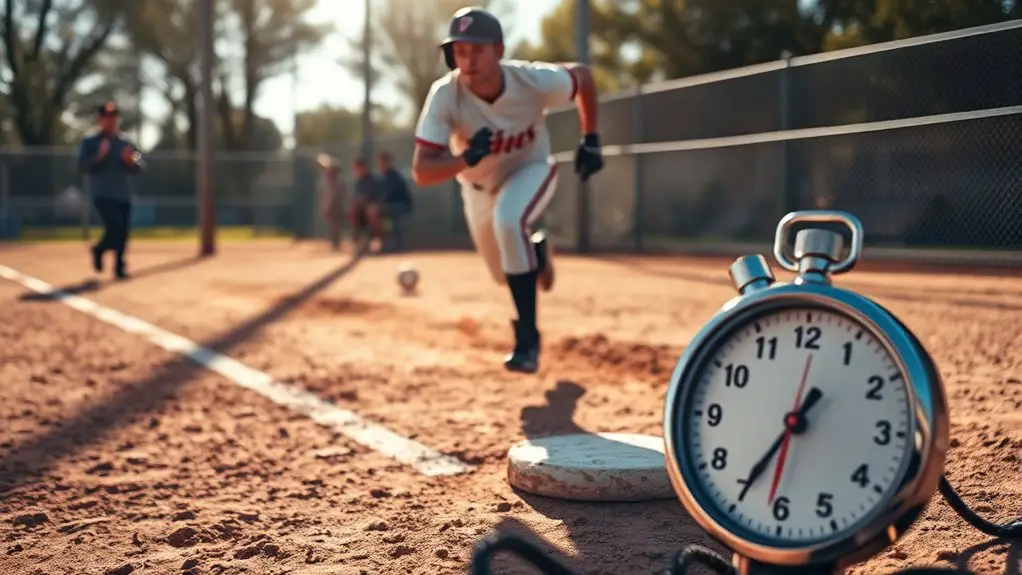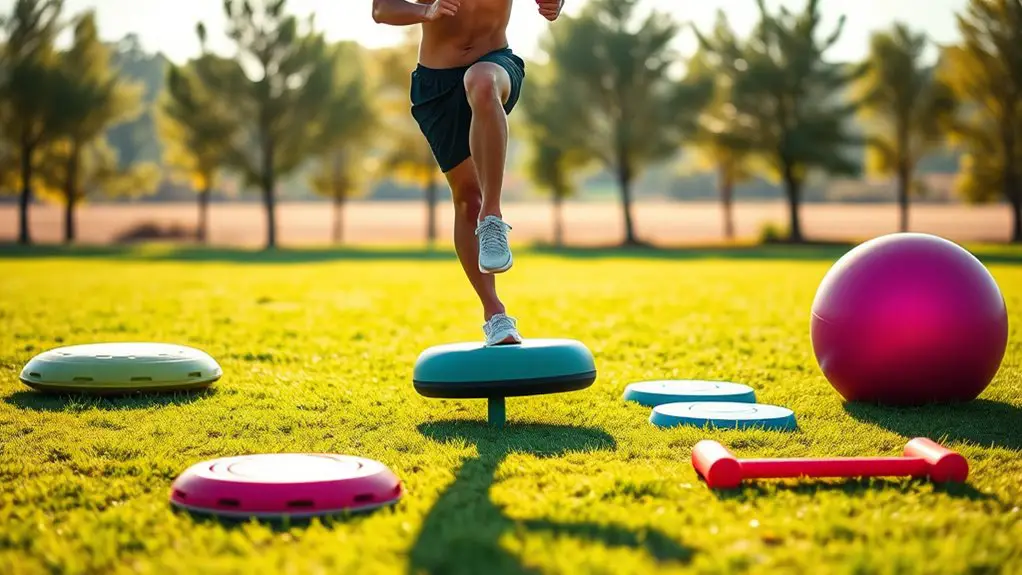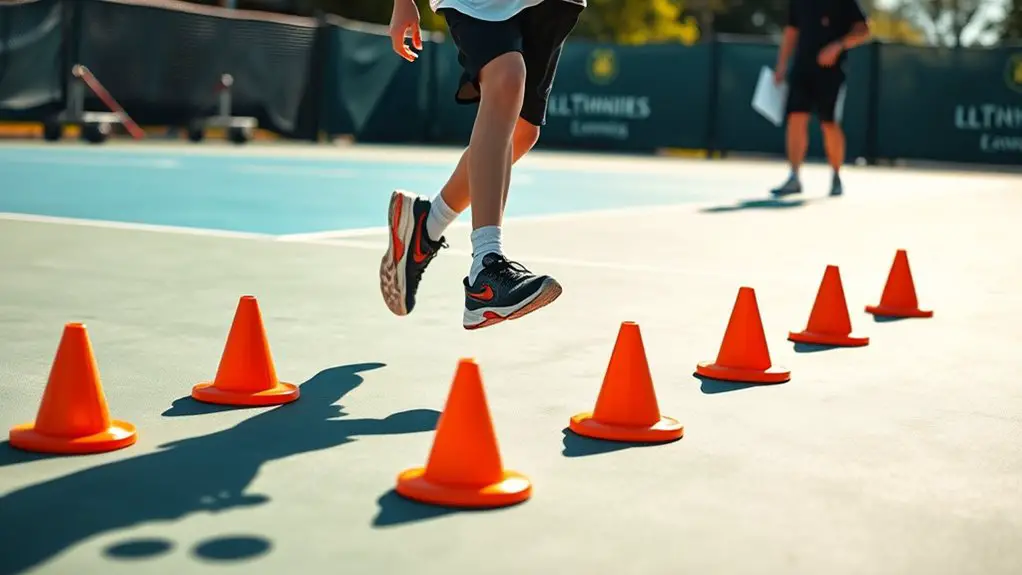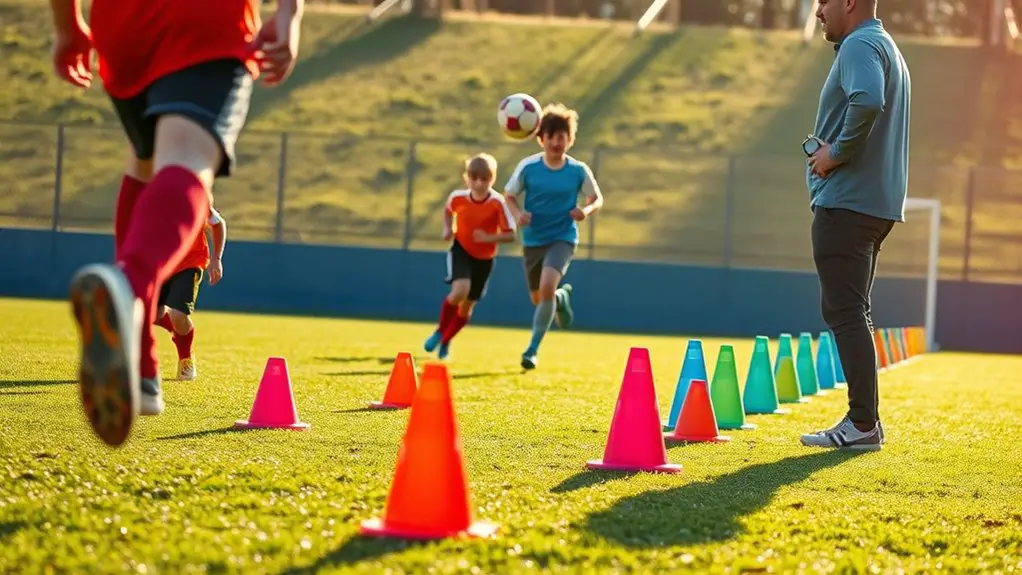To train for faster baserunning and stolen bases, focus on your speed mechanics and first stride explosiveness. Work on your form by keeping your head up and knees high. Use agility ladders and speed hurdles to enhance your foot speed and power. Always practice your lead timing by reading the pitcher's motion. Don't forget to master your sliding techniques for safety. Keep honing these skills, and you'll discover even more ways to improve your game.
Understanding the Basics of Baserunning
When it comes to baserunning, there are a few key fundamentals every player should grasp. First, you've gotta understand your speed mechanics. This means knowing how to accelerate quickly and maintain your speed as you run the bases. Work on your form—keep your head up, and your knees high.
Next, focus on your first few strides; they're essential in gaining ground. A strong push-off from the base can set the tone for a successful run. Additionally, practice reading the pitcher and the ball, so you're always ready to make that break.
Lastly, it's important to know your surroundings. Awareness of where the ball is and what the defense is doing can open up opportunities. These baserunning fundamentals will help you become a more effective player, giving you the freedom to take risks and seize chances on the field. Embrace them, and let your instincts guide you! Incorporating agility ladder drills into your training can significantly enhance your foot speed and coordination, making you a more agile baserunner.
The Importance of a Quick First Step
While a strong overall running technique is essential, a quick first step can make all the difference in baserunning. When you're on the base, your ability to react quickly can set you apart from the competition. A quick reaction to the pitch or a fielder's movements allows you to seize opportunities and take those extra bases.
You need to harness explosive power right from the start. That first push off the base is vital; it's your chance to create momentum. If you can explode out of your stance, you'll gain an edge over the defense. Incorporating plyometric exercises for explosiveness into your training can significantly enhance your first step and overall sprinting ability.
Drills to Improve Speed and Agility
Improving your speed and agility on the bases can be achieved through various targeted drills. Incorporating tools like the agility ladder and speed hurdles into your training routine will help you develop the quickness and coordination needed for successful baserunning. Additionally, focusing on strength training can enhance your muscle power for directional changes during gameplay.
Here's a straightforward drill table to get you started:
| Drill Type | Equipment | Focus Area |
|---|---|---|
| Ladder Drills | Agility Ladder | Foot speed & coordination |
| Hurdle Sprints | Speed Hurdles | Explosive power & stride length |
| Lateral Shuffles | None | Side-to-side agility |
Mastering the Art of the Lead
Mastering the art of the lead can be a game-changer for your baserunning strategy, as it sets the tone for your next move. A well-timed lead not only gives you an edge but also keeps the defense on their toes. Here are some lead techniques to enhance your game:
- Initial Position: Start a few feet off the base, maintaining a balanced stance for quick movement.
- Read the Pitcher: Keep your eyes on the pitcher's motion to gauge their focus and timing before taking your lead.
- Explosive First Step: When you decide to take off, your first step should be quick and decisive to maximize your chance of stealing.
Focusing on lead timing will help you develop confidence and instinct on the basepaths. With practice, you'll find that mastering the lead can truly elevate your baserunning skills and create more opportunities for success. Additionally, incorporating footwork drills into your training regimen will enhance your agility and reaction time, further improving your effectiveness on the bases.
Timing Your Steal: Key Considerations
Once you've perfected your lead, the next step is understanding when to make your move toward stealing a base. Timing's everything, and you need to read the pitcher's cues to make that decisive leap. Here's a simple breakdown to help you out:
| Pitcher Cues | Steal Timing |
|---|---|
| Quick delivery | Go on the first move |
| Long windup | Wait until the release |
| Glance at the runner | Anticipate the throw |
| High leg kick | Steal on the down motion |
| Focused on catcher | Stay put for now |
Practicing Sliding Techniques for Safety
When you're stealing bases, knowing how to slide safely is vital. Practicing proper sliding form and landing techniques can help you avoid injuries while maintaining speed. Let's explore how to master these essential skills for safer baserunning.
Proper Sliding Form
Sliding safely into a base can make all the difference in a close game. To master proper sliding form, focus on these key techniques:
- Proper foot placement: Lead with your foot, aiming to hit the base with your toe for a smooth shift.
- Effective body alignment: Keep your body low and tilted slightly forward as you slide, which helps maintain balance and control.
- Stay relaxed: Tension can lead to injury; keep your limbs loose and ready to react.
Practicing these elements will not only enhance your sliding technique but also boost your confidence on the field. Remember, the right form can prevent injuries and keep you in the game. So, get out there and slide like a pro!
Safe Landing Techniques
To guarantee a safe landing during your slides, it's vital to practice techniques that minimize the risk of injury. Focus on leading with your dominant foot and keeping your body low; this helps absorb the impact. As you slide, tuck your chin to avoid whiplash and extend your arms to protect your torso. Your hands should lead the way, creating a natural barrier against the ground. It's also important to choose a smooth surface to practice on, as this can enhance your control and confidence. Remember, mastering these techniques not only promotes a safe landing but also boosts your performance on the basepaths. Prioritize injury prevention, and you'll feel freer to steal those bases with ease!
Analyzing Pitcher and Catcher Tendencies
Understanding pitcher and catcher tendencies is essential for improving your baserunning skills, as it allows you to anticipate their moves and react accordingly. By analyzing pitcher habits and catcher signals, you can gain a significant edge on the basepaths. Here's how to get started:
- Observe Pitcher Habits: Notice any patterns in their delivery time and focus. Are they quick to the plate or do they take their time?
- Watch Catcher Signals: Pay attention to how catchers signal pitches. Knowing what pitch is coming can inform your decision to steal or stay put.
- Timing Your Break: Use your observations to time your break from the base. A well-timed jump can make all the difference. Incorporating quick foot movement into your training can enhance your ability to react swiftly during critical moments.
Frequently Asked Questions
What Footwear Is Best for Improving Baserunning Speed?
When it comes to improving your baserunning speed, the right footwear is essential. You'll want to focus on cleat selection, as the right cleats can provide the traction you need to push off quickly and maintain balance. Look for styles that fit snugly and offer good grip, allowing you to make sharp turns without slipping. Remember, solid traction is key to releasing your speed and gaining that freedom on the bases.
How Can Nutrition Impact My Baserunning Performance?
Imagine your body as a finely tuned machine, ready to break free and sprint towards victory. Nutrition's the fuel that powers this machine. By achieving a macronutrient balance—carbs for energy, proteins for muscle repair, and healthy fats for stamina—you'll feel unstoppable. Don't forget hydration strategies; staying hydrated keeps you sharp and agile. Embrace these elements, and you'll release your full potential on the basepath, running wild and free.
Should I Focus on Strength Training for Faster Baserunning?
Yes, you should definitely focus on strength training for faster baserunning. Building explosive power will enhance your speed and agility on the field, giving you that edge you're looking for. It'll help you push off the base quickly, making those vital steals easier. With the right strength workouts, you'll not only feel more powerful but also gain the freedom to make quicker decisions during the game. Embrace the grind, and watch your game elevate!
How Do Mental Strategies Affect Baserunning and Stealing Bases?
Imagine standing at first base, heart racing, and you sense the pitcher's intentions. Mental strategies like visualization techniques can transform your confidence. Picture yourself stealing second, feeling the adrenaline rush, as you anticipate the perfect moment to take off. Game awareness is vital; it helps you read the field and the pitcher's patterns, allowing you to make split-second decisions. When you combine these strategies, you're not just running—you're playing with freedom and finesse.
What Are Common Injuries Associated With Baserunning?
When you're out there sprinting on the bases, it's essential to be aware of common injuries that can sideline you. Ankle sprains often happen during quick cuts, while hamstring strains can occur from explosive acceleration. Knee injuries can arise from improper landing or sudden stops, and groin pulls are a risk with intense lateral movements. Staying injury-free not only keeps you in the game but also gives you the freedom to play at your best.




